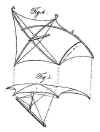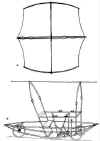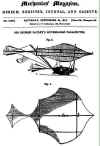| 1799 Sir George Cayley, a baronet in Yorkshire, near Scarborough,
England, conceives a craft with stationary wings to provide lift and
"flappers" to provide thrust. It also has a movable tail to
provide control. So convinced is he that this idea is an earth-shaker, he
engraves a drawing of this craft on a silver disk. Cayley is the first to separate the
different forces that keep an aircraft in the air, and his engraving is the first recorded
drawing of a fixed-wing aircraft -- an airplane. |
Click
on the pictures to enlarge them.

The silver disc on which Cayley engraved his concept of a fixed wing
aircraft in 1799. The opposite side shows vectors that represent lift and thrust. |
| 1804 Sir George Cayley, England, builds a miniature glider with a
single wing and a movable tail mounted on a universal joint. It also has a movable weight
to adjust the center of gravity. It is the first recorded fixed-wing aircraft of any size
capable of flight. |

A reproduction of Cayley's 1804 glider. |
| 1809Sir George Cayley
builds a man-sized version of his glider with a wing surface of 300 feet. An assistant
makes a few tentative hops in the air, holding onto the fuselage.
Sir George Cayley begins to publish On Aerial Navigation,
a three-part article which appeared in Nicholsons Journal of Natural Philosophy. It
is a milestone and for the first time defines the three elements required by an aircraft
lift, propulsion, and control. |

An illustration of Cayley's 1809 Glider from On Aerial Navigation. |
| 1810-1840Sir George Cayley tries three times to organize an
aeronautical society to study the problem of flight, but finds little interest among
scientists. |

Cayley also designed lighter-than-air craft. This dirigible sketch, which
Cayley published in the Philosophical Magazine in 1817, was years ahead of its
time. Note the lifeboat suspended from a parachute. |
| 1831
Thomas Walker proposes a tandem-wing airoplane with the pilot
and the propulsion system amidships. This would later influence Samuel
Langley as he designed his aerodromes. |

Walker's tandem-wing design featured a wing whose
camber was upside down. Had it been built, it would have stayed firmly on
the ground. |
| 1843William Samuel Henson,
England, proposes the Aerial Steam Carriage in Mechanics
Magazine, the first known design for a propeller-driven fixed-wing aircraft. |

Henson based the deign of his Aerial, as he called it, on Cayley's
work. He asked Cayley for support in building the craft, but Cayley declined. |
| 1845-48William
Samuel Henson and John Stringfellow attempt to form the Aerial Transit Company,
which (if only they had a practical airplane), would have been the world's first airline.
To drum up support, they build and test a model of Henson's aerial carriage with a 20-foot
wingspan. It makes brief glides, but does not sustain flight. |

This promotional illustration, printed on a handkerchief, promised the Aerial
Transit Company would get you to "China in 24 hours certain." |
| 1849 Sir George Cayley builds a small glider designed
to lift about 80 pounds of the ground. He refers to it as his Boy Glider. It is the first
recorded manned (or boyed) fixed-wing aircraft. It lifts a 10-year old boy off the ground
for a few yards on test runs. Cayley also flew it in a high wind like a
kite, tethered to the ground. |

Cayley's sketch of his Boy Carrier, the first manned aircraft.

Plans for the Boy Carrier.
|
| 1853Sir George Cayley
builds an improved version of his glider and convinces his coachman to pilot it. The
coachman, whose name is lost to us, makes an wavering, uncontrolled glide of a few hundred
feet -- the worlds first true manned flight in a fixed-wing aircraft. The coachman
quits Cayleys service immediately after his one and only feat of airmanship,
reportedly saying, "I wish to give notice, sir -- I was hired to drive, not to
fly." |

Cayley published the design of his "coachman carrier" in 1852 in Mechanics
Magazine. Cayley, by the way, never referred to his craft as gliders. He called them
"governable parachutes." |
![]()
![]()
![]()